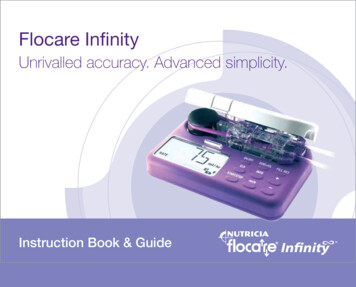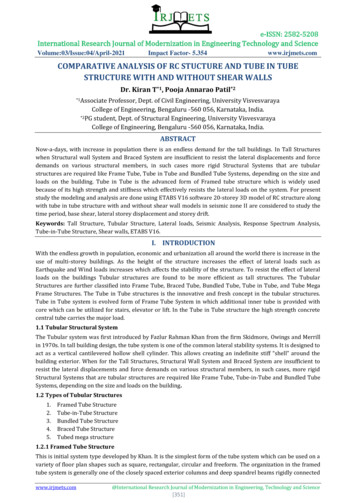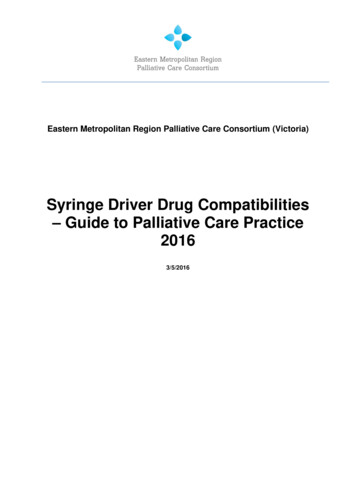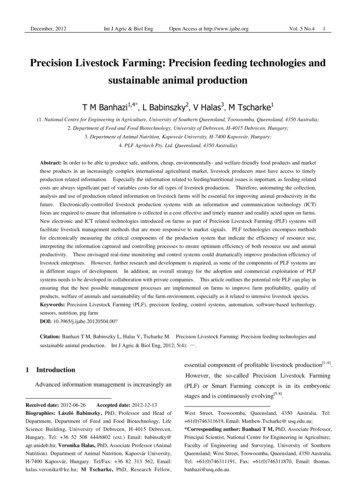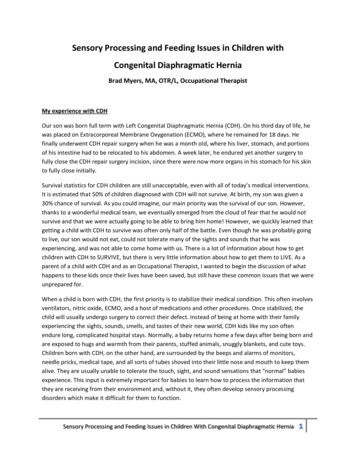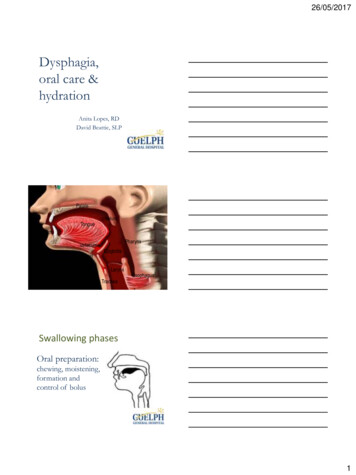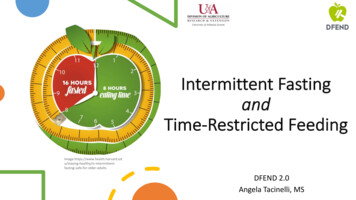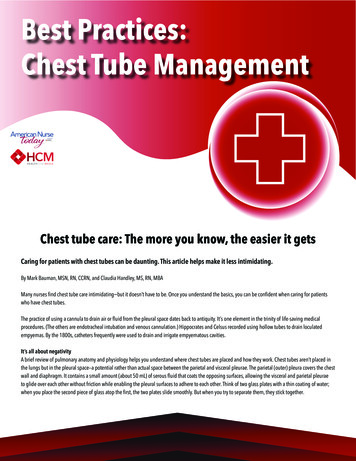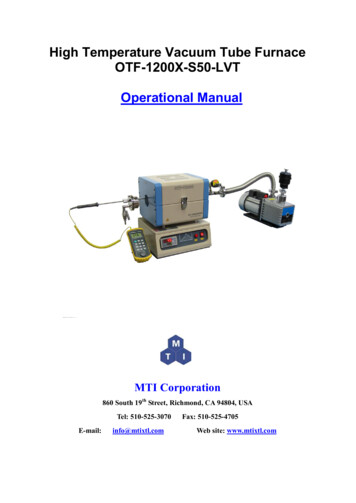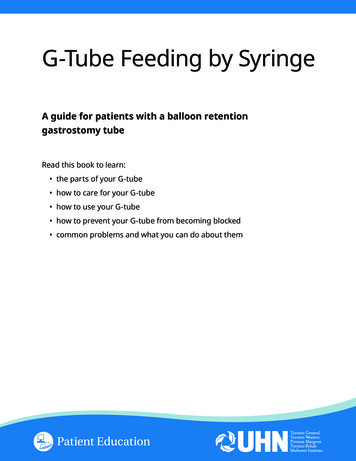
Transcription
G-Tube Feeding by SyringeA guide for patients with a balloon retentiongastrostomy tubeRead this book to learn: the parts of your G-tube how to care for your G-tube how to use your G-tube how to prevent your G-tube from becoming blocked common problems and what you can do about them
You had a gastrostomy tube (G-tube) put in your stomach to give your bodynutrients and fluid. This booklet will guide you through the things you needto do and know to take care of yourself. You will also learn how to deal withany problems you may have.At first, you may be scared or unsure about using your G-tube for feeding.This is normal. With practice you will feel more comfortable and will be ableto go through the steps more quickly.If you have any questions, contact your nurse at Princess Margaret CancerCentre using the important numbers in Section F.Table of ContentsSection Apage 2Understanding the parts of your gastrostomy tubeSection Bpage 4How to care for your gastrostomy tubeSection Cpage 12How to use your gastrostomy tube:A step by step guide using the syringe methodSection Dpage 18How to prevent your gastrostomy tube from becoming blockedSection Epage 20Common problems and what you can doSection FImportant phone numbers1page 24
Section AUnderstanding the parts of your gastrostomy tubeMy bolster position:Sterile water in my internal balloon:2
BalloonThis balloon is filled with sterile water and helps to keep your G-tube frommoving outside the stomach. You will be told how much sterile water is inyour balloon so it can be checked by a homecare nurse.TubingThe tubing connects the internal balloon to the ports. It lets the water,formula and medication get into your stomach. The tubing also has numberson it which help you to check if your bolster is at the correct position.BolsterThis is the clear, round piece of soft plastic that sits directly on top of the exitsite. The bolster helps to keep your G-tube from moving further inside yourstomach.Bolster PositionThe number on the tubing closest to the bolster is your bolster position.Your bolster position should always remain the same. You will be told yourbolster position so you can check it every day.Exit SiteThe area of skin on your abdomen (belly), under the bolster, where thefeeding tube comes out.Medication PortThis is where you will give yourself medications.Feed PortThis is where you will give yourself formula.Balloon PortThis port allows the amount of sterile water in the balloon to be checked.Only a nurse or doctor should use this port.3
Section BHow to care for your gastrostomy tubeHow do I care for the exit site?After you get your G-tube, there will be a gauze dressing under the bolster.This gauze dressing should be removed the next day. You don’t need thedressing. It’s better if the exit site is left open to the air.Daily cleaning of the exit siteWash your hands with soap and water before you begin.For the first 3 days after your G-tube is put in: Clean under the bolster and around the exit site with the chlorhexidineswabs you were given two times a day. These swabs have a specialantiseptic (germ killing) wash on them. Leave it to air dry.After 3 days, clean under your bolster and around your exit site every dayusing mild soap and water on a clean, damp cloth. To clean under the bolster: Secure the upper half of the bolster withyour thumb and gently lift the bottom ofthe bolster up so you can clean the skin. Repeat to clean the skin under the upperhalf of the bolster. Gently pat it dry.4
Can I take a shower with my G-tube in place?Showering with a feeding tubeYou do not need to cover your G-tube when showering. Letting soap andwater running gently over the tube will not hurt it. Don’t let the water stream directly hit the G-tube. Don’t rub soap onto the G-tube. Make sure you pat dry around the tube and under the flange once youare done.Do not take a bath when you have a G-tube.Checking your G-tube exit site every dayEvery day, look at the exit site of your G-tube to make sure it is ok. You cando this while you are cleaning it.What should I watch for?1. Check for redness or pus. If you are having radiation treatment and you see any pus, or your exitsite looks red and feels tender, tell your nurse in your weekly reviewappointment or visit the radiation nursing clinic. If you finished radiation treatment and have home care, tell the visitingnurse or call the Clinic Site Telephone Line. See page 24 for importantphone numbers. Or, visit your family doctor to check the exit site. If these signs of infection happen in the evening or on the weekend, goto your local emergency room.5
Daily bolster careAfter cleaning the exit site:Turn the bolster. Place both hands on the bolster andgently turn it (which will turn the entireG-tube) one full circle so the bolster isback to its original spot. It doesn’t matter what direction you turn the bolster.You can turn it to the left or to the right.You need to turn the bolster once a day for 1 month after you get thetube. This helps to stop skin from growing onto and sticking to the tube.The date I can stop turning my bolster is:2. Check the bolster position. The day after you get your G-tube, during your education session, youwill be shown your bolster position number. Your bolster must alwaysstay at this number.My bolster position number is: If your bolster is at a different number oryour bolster no longer sits just above of theexit site, (for example, there is now moreroom between the exit site and bolster), itmay mean your feeding tube has movedinside or outside your stomach.6
If you think your feeding tube may have moved, don’t use yourG-tube and don’t eat or drink by mouth (if you are able to) until youspeak to a health care professional and they tell you it is safe to do so. If you are having radiation treatment and you think your tube hasmoved, tell your nurse in your weekly review appointment or visit theradiation nursing clinic. If you finished radiation treatment call the Clinic Site Telephone Line forinstructions. See page 24 for important phone numbers. Or go to yourlocal emergency room to check your feeding tube. Your G-tube needs to be changed every 6 months. Ask your doctor ornurse practitioner to enter an order first and then call InterventionalRadiology at 416 340 3384 (Monday to Friday 8:00 - 4:00 pm) to get anappointment time. Do NOT eat or drink anything 8 hours before theG-tube change.If your tube comes out completely, cover the exit site withsterile (clean) gauze. Do not eat or drink by mouth (if you areable to do so) and go to your local emergency department.Try to go to Toronto Western Hospital or Toronto General Hospital if youlive in Toronto. Both are part of University Health Network along withPrincess Margaret Cancer Centre.Checking your balloon once a weekA home care nurse will be arranged to help you check and care for yourfeeding tube. This nurse will start weekly balloon checks 2 months after yourG-tube was put in.My balloon checks should begin:The amount of sterile water in my balloon is:7
How to do a balloon check:The information below is to help your visiting nurse when they do yourballoon check. Do not check the balloon when you are using the tube for feeding.Once you are finished, flush the feeding tube with 30 ml of water.A. Attach an empty 10 milliltres leurtip syringe to the “balloon” port.B. Place one hand firmly on the flange.This will stop your G-tube fromaccidentally slipping out of yourstomach during the balloon check.C. Slowly pull back on the syringe’splunger. This will pull the sterile waterfrom the balloon into the syringecausing the balloon to deflate. Keeppulling back on the plunger until nomore sterile water comes out.D. Check the syringe to see howmuch sterile water was inthe balloon. It should be theamount put in during yourprocedure and written above.E. Gently push on the syringe plungerputting the sterile water back intothe balloon. This will cause yourballoon to inflate.8
F. If the amount of sterile water is less than it should be, the missing amountneeds to be added to keep your balloon properly inflated. For example,you need to have 6 ml and only 5 ml was in the balloon. You need to addthe 1 ml of sterile water into the balloon.Important: Less sterile water can cause you G-tube to move out of thestomach.G. Only when the balloon is inflated should you remove your hand off thebolster.Adding missing sterile water into the balloon: If you need to add sterile water, remove the syringe from the balloonport. Put the syringe in sterile water and pull the plunger. This will pull waterinto the syringe. Stop when you get to the amount you need. Attach the syringe again to the balloon port. Gently press on the plunger putting the missing sterile water into theballoon.If your balloon has less sterile water then it should 3 weeks in a row,your balloon may have a leak. In this case, it is important that yourG-tube be checked. Call the Clinic Site Triage Line (see page 24 forimportant numbers) and they will help to arrange a G-tube check.9
Section CHow to use your gastrostomy tube:A step by step guide using the syringe methodThis section will teach you how to: gather supplies for your feeding flush your G-tube feed yourself clean up after the feeding give yourself medicine through your G-tubeRemember these important safety tips: Putting blended or pureed food into the feeding tube can cause it to becomeblocked. The only things you should ever put through your feeding tube are: water store-bought formula that a registered dietitian has approved medications that your health care team have approved Make sure to clean your work surface before gathering your supplies. Wash your hands with soap and water before you begin your feeding. Always stay in a sitting position during your feeding. Don’t lie down. After your feeding you should continue to sit up, or you may take a walk.Don’t lie flat for 1 hour after your feeding is finished. If you lie flat, theformula could back up from your stomach and go into your lungs. This isalso called aspiration. You should use a new syringe about every 7 days. Even if you rinse it, itcan become dirty over time and harder to use. Talk to your CACC coordinator or registered nurse during reviewappointments with your doctor. They can let you know where youcan get new syringes.10
Clean your work surface.This will keep harmful bacteria (germs) from getting on your supplies.Step 1: Gather your suppliesHere is a list of supplies you need to gather before you begin.FormulaFormula is liquid food that you buy at the pharmacy.It usually comes in a can, bottle or Tetra Pak box.The formula has all the nutrients, vitamins andminerals you need to stay healthy.There are many different types of formula you canbuy. Some examples are Nutren 1.5 or Isosource .Always store the formula at room temperature.2 Catheter-tip syringes(60 millilitres, equal to 2 ounces)There is a 3-centimeter (1 inch) tip on it. You will usethe syringes to flush your G-tube with water and togive yourself medicine and formula.Glass of room temperature water and anotherempty glassRoom temperature water is used to flush your G-tubeto make sure it is working properly. Using cold watercould cause you to have pain or cramps in yourabdomen (belly area).The other glass will hold formula.11
Clean paper towelsUse paper towels to protect your clothes from stainsand spills. Choose one without any dye or print.Place your supplies on top of the cleaned work surface, like a table.Place a chair next to the table to sit on during your feeding.Step 2: Wash your handsAfter gathering your supplies: Wash your hands with soap that hasno perfume in it (unscented soap). Dry your hands using a clean towel.Step 3: Flush your G-tubeFlushing your G-tube before each feed will make sure it is working welland isn’t blocked.A. Remove the cap from your syringe.12B. Place the tip below thewaterline to make sure no airgoes into the syringe. Fill thesyringe with 60 millilitres ofroom temperature water.
C. Aim the tip of the syringe upin the air. Squeeze a tiny bit ofwater out of the tip to make surethere is no air left in the syringe.D. With one hand pinch the tubinginto a V shape. This will help tostop fluid from spilling from theG-tube when the cap is removed.E. As you keep pinching the tubing,remove the cap on your G-tubefrom the middle “feed” port.F. Keep pinching the tubing and insertthe tip of the syringe filled withwater into the opened feed port.G. Stop pinching the tubing.H. Slowly push the plunger on thesyringe so the water goes intoyour G-tube.13
I. With one hand pinch the G-tubetubing back into a V.J. Remove the syringe and put thecap back on the “feed” port.K. Stop pinching the tubing.L. Put the cap back onto your syringe.If you have trouble pinching your tubing into a V, speak to a nurse atPrincess Margaret about using a clamp. It is very important that youonly use a non-toothed, rubber shod clamp (as pictured below). Thisclamp helps to make sure the tubing doesn’t become damaged.14
Step 4: Feeding yourself the formulaSit on the chair by the table with your supplies. To give yourself formulathrough your G-tube.A. Shake the can or Tetra Pak offormula and open itB. Pour the formula into theclean glassC. Fill the syringe with formulaand place it on the table.D. Place a clean towel under the endof your G-tube. Placing a towel onyour lap will protect your clothesfrom formula that might drip fromyour tube during your feeding.E. Make sure to pinch the tubinginto a V to prevent fluid fromleaking.F. As you keep pinching the tubing,open the middle cap from the “Feed”port at the end of your G-tube.15
G. Keep pinching the tubing andplace the tip of the syringe full offormula into the “Feed” port.H. Stop pinching your G-tubetubing and slowly push in theformula. Take 1 to 2 minutes toempty the syringe.I. Pinch the tubing again after thesyringe is empty.J. Remove the syringe and closethe cap. Stop pinching thetubing.K. Wait 2 to 3 minutes and repeat with another syringe full of formula. A250 millilitre can or Tetra Pak of formula should fill your syringe 4 times.L. After the last syringe of formula, fill your syringe with 60 millilitres ofwater and flush your G-tube.M. Close the cap on the “feed” port.16
Remember: Wash your hands with soap and water before you begin your feeding. Stay in an upright sitting position while you feed yourself formula. Don’t lie flat for 1 hour after feeding yourself formula. This reduces therisk of feed backing up and going into your lungs. If you feel bloated after the feeding, try waiting longer (about 5 minutes)between giving yourself each syringe.Step 5: Cleaning the syringeAfter each feed:Take the syringe apart and rinse with warm soapy water and a bottle brush.Allow it to air dry.Can I give myself medicines through my feeding tube?1. Talk to your doctor, pharmacist or registered nurse about any medicinesyou are taking. They can help show you how to put medicines throughyour feeding tube.2. Not all medicines are safe to crush. Ask your pharmacist if you are notsure. Ask if the medicines you are taking are available in a liquid. Some medicines, like the most common pain killers and anti-nauseamedicines are also available in liquid form.3. Crush pills that are safe to crush into a fine powder. Add 30 millilitresof water to the powdered medicine and mix well until the medicine isdissolved.4. Flush your G-tube through the “Med” port with 60 millilitres of roomtemperature water before you give yourself the medicine.5. Fill a catheter tip syringe with the water and medicine mixture and followthe steps above to give yourself the medicine.17
6. Take different medicines 1 at a time. If you are taking more than 1medicine, flush your feeding tube with 30 millilitres of room temperaturewater between each one. Don’t mix the different medicines.7. Flush your tube well with 60 millilitres of room temperature water afteryou finish taking all your medicines.Section DHow to prevent your gastrostomy tube from becoming blockedA blocked G-tube will prevent you from taking your medications, formulaand water flushes. You can lower the chances of your G-tube becomingblocked by taking these steps:1. If you are not needing to use your feeding tube, still flush with 60millilitres of water in the morning and night.2. Only put medications that have been okayed by either your doctor orpharmacist into your G-tube.3. Make sure you crush your medicines well before putting them throughyour G-tube. Flush with 60millitres of room temperature water beforeand after medication.4. No food or drinks other than your prescribed formula should go intoyour G-tube.5. Always shake the can of formula well before using it. Do this to makesure it is mixed well (especially if your formula has fibre).6. Flush your tube with 60 millilitres of room temperature water before andright after you finish a feeding18
NEVER try to unblock your feeding tube if you think it hasmoved or come out of the insertion site. Please follow theinstructions on page 15 if your tube has moved.What should I do if my G-tube becomes blocked?If your G-tube becomes blocked or if the flow is slower than usual:1. First, use the syringe to flush the tube a few times with roomtemperature water using gentle pressure.2. If this doesn’t work, contact the Clinic Telephone Line or your doctor atPrincess Margaret Cancer Centre for further instructions.3. If your G-tube becomes blocked weeknights or on the weekend, go toyour local ER and give the instructions below to them so the emergencyroom staff can unblock the tube.This section is for ER staff ONLY.Instructions for unblocking G-tubes:1. You will need: 1 Cotazyme capsule 1 500 milligram sodium bicarbonate tablet2. Open the Cotazyme capsule and mix with the 500 milligram tabletof crushed sodium bicarbonate.3. Add 10 millilitres of water to the mix and stir to make a slurry.4. Draw the mixture into a syringe, and inject it into the G-tube.5. Wait 20 minutes to let the mix take effect and then try to flush thetube with 60 millilitres of water.19
Section ECommon problems and what you can doThis section gives you information about how to manage common problemsthat you may have with your G-tube, including: nausea and/or vomiting diarrhea constipation (hard stool or no stool)These problems can happen for many reasons, whether you are using yourG-tube or not. They can be mild or severe.Using your G-tube should not add to your feeling of nausea or affect yourbowel movements. If you notice a change, try the tips below. If the tips don’thelp, contact a member of your health team so they can help you feel better.Nausea and vomitingNausea and vomiting can be caused by your illness, treatment, certainmedicines or even how fast you are feeding yourself. Give yourself formula slowly. Taking about 20 to 30 minutes to feed yourself will help prevent nauseaand vomiting. Push each syringe of formula slowly and take a 5-minute break betweeneach syringe.Speak to your health care team if you don’t have anti-nausea medicine orthe one you have isn’t working.20
DiarrheaFeeding yourself slowly can help prevent diarrhea. If you are doing this andstill have diarrhea after your feeds, call your dietitian (if you have one) orthe Clinic Site Triage Line (see page 24 for important phone numbers). Therecan be many causes of diarrhea. You may need to do some tests to check forother causes. You may also need to switch to another type of formula.Replace the fluids you lose from diarrhea by drinking more fluids or puttingextra water through your G-tube.Don’t use anti-diarrhea medicines like Imodium without talking to yourdoctor or nurse first.How to avoid dehydration (not having enough fluid in your body)You can easily get dehydrated when you have diarrhea, are vomiting, or noteating or drinking enough. The average person needs about 8 cups (2 litres)of fluid a day. This can include all fluids such as: juice, sports drinks or Jell-O milk, ice cream or formulas soups tea, coffee and water.Remember: 4 syringes (60 millilitres each) equals only 1 cup of water.If you are unable to eat or take formula through your tube, increase theamount of water you give yourself through your tube.If you feel you are becoming dehydrated, call or visit the hospital.Go to page 24 for important phone numbers and who to call.21
ConstipationConstipation can be caused by many things. The most common reasons whyyou may be constipated when using your G-tube are: It’s a side-effect of the pain medicines you are taking You are taking in less fluids (either fluids taken by mouth or fluids takenthrough your G-tube)If your pain medicines are making you constipated, taking in more fluidand/ or doing more water flushes through your tube may help. For example,giving yourself 2 syringes of water (120 millilitres) through your G-tubebetween your feedings can add up to almost 3 extra cups of water a day (ifyou are feeding yourself 6 times a day).You should also follow a bowel routine:A helpful resource at the Princess Margaret Patient & Family Library (mainfloor) is called Bowel routine for preventing constipation from painmedications. You can also find this information on the Internet at:www.uhn.ca/PatientsFamilies/Health Information/Health Topics/Documents/Bowel Routine for Preventing Constipation.pdfIf your doctor or nurse gave you a prescription for laxatives and/or stoolsofteners, follow the instructions when taking them. If you did not get aprescription, please ask your registered nurse or doctor for one.22
Talk to your health care team or go to the Radiation Nursing Clinicif you are still having radiation treatment and: Have nausea and vomiting for more than 6 to 8 hours Feel you are becoming dehydrated: you are not able to take enough fluids (8 cups) each day either bydrinking or through your G-tube you are weak or dizzy when you get up from bed or from a chair are passing less urine and the urine is darker Are having trouble with your bowels, such as: blood or mucus in your stool 3 or more loose bowel movements in a day severe cramping no bowel movement for 3 days Are having trouble with your G-tube: flushing does not unblock your tube the skin around your exit site is getting red and painful feeding formula is leaking out of your exit siteGo to page 24 for important phone numbers and who to call.Go the hospital right away if your feeding tube falls out.23
Section FImportant phone numbersHere is some important contact information for your health care team atPrincess Margaret Cancer Centre. Call these numbers if you need help whileyou are on treatment or after your treatment is completed.While you are on treatment:Weekdays (Monday-Friday) 9:00 am to 5:00 pm: Call the Head and Neck Nursing Telephone Line or go to the RadiationNursing Clinic, level 2B at Princess Margaret Phone: 416 946 4501 extension 6558In evenings (after 5:00 pm), weekends and holiday: Call the Princess Margaret Cancer Centre and ask to speak to theNursing Coordinator Phone: 416 946 2000After your treatment is complete: Call the Clinic Site Telephone Line Phone: 416 946 4501 extension 2206Dietitian: Phone: 416 946 4501 extension 5266If at any time you need help in an emergency, go to your nearesthospital emergency department.24
Other important numbers:25
Notes:26
Visit www.uhnpatienteducation.ca for more health information.Contact us to provide feedback or request this brochure in a different format, such aslarge print or electronic formats: pfep@uhn.ca 2019 University Health Network. All rights reserved.Use this material for your information only. It does not replace advice from your doctor or other health care professional.Do not use this information for diagnosis or treatment. Ask your health care provider for advice about a specific medicalcondition. You may print 1 copy of this brochure for non-commercial and personal use only.Form: D-5685 Author: Lisa Tinker Revised: 10/2019
Don’t lie flat for 1 hour after your feeding is finished. If you lie flat, the formula could back up from your stomach and go into your lungs. This is also called aspiration. You should use a new syringe about every 7 days. Even if you r
